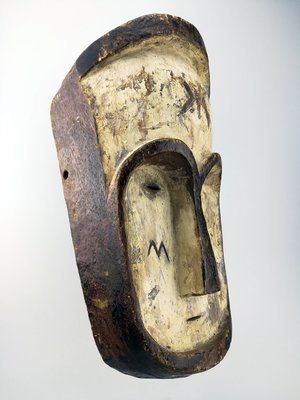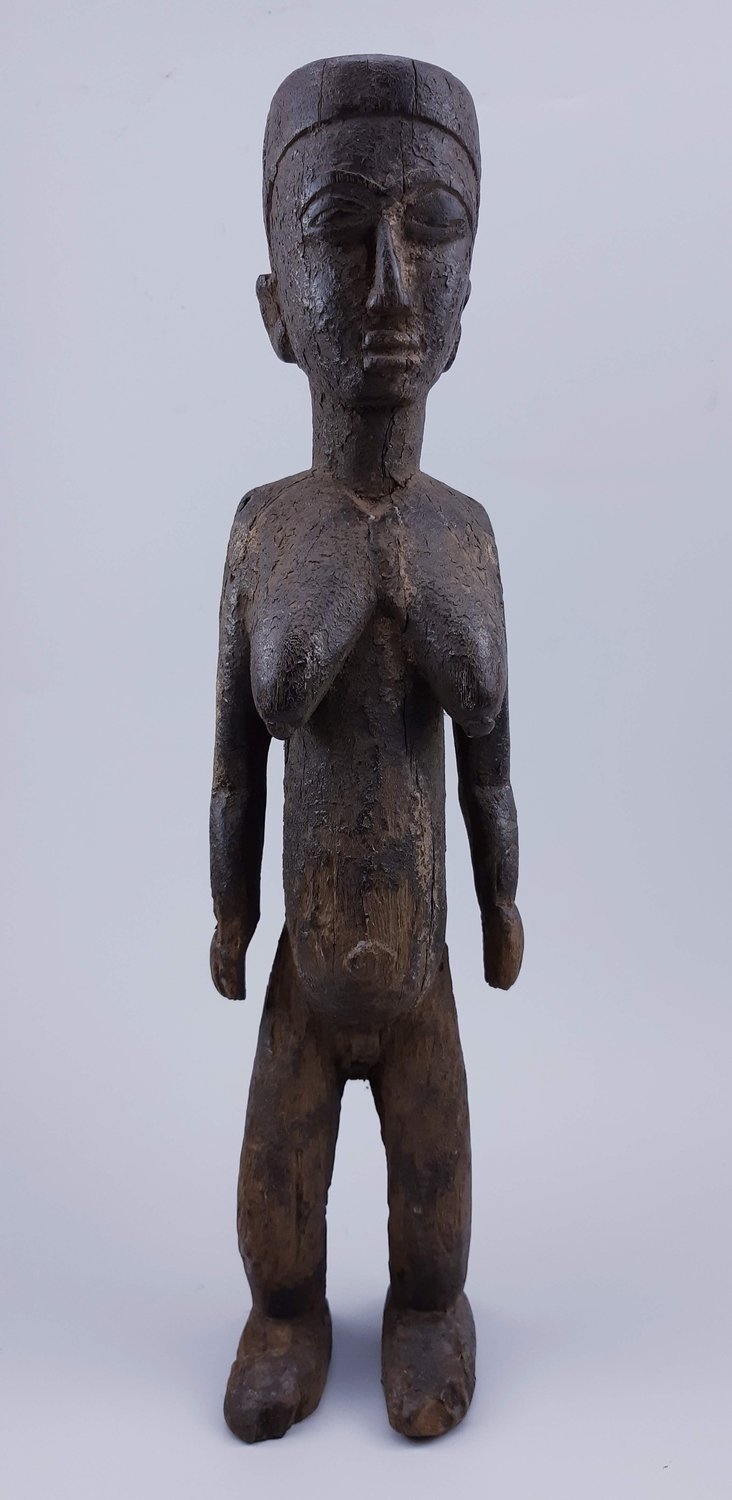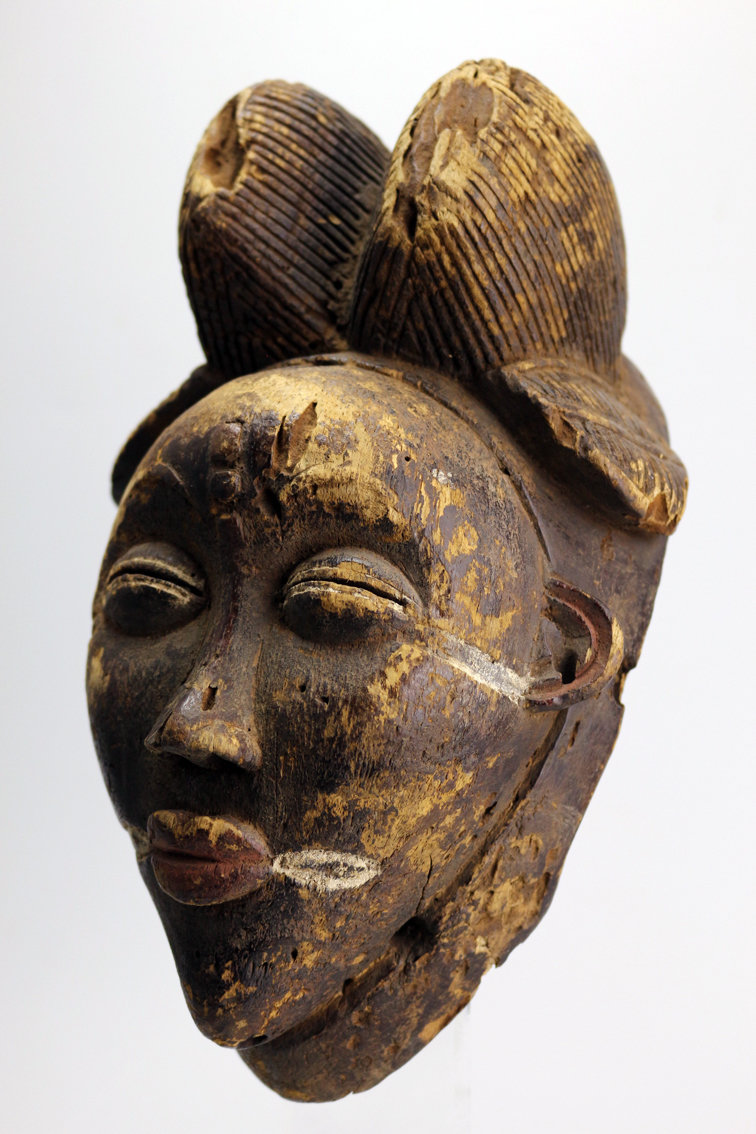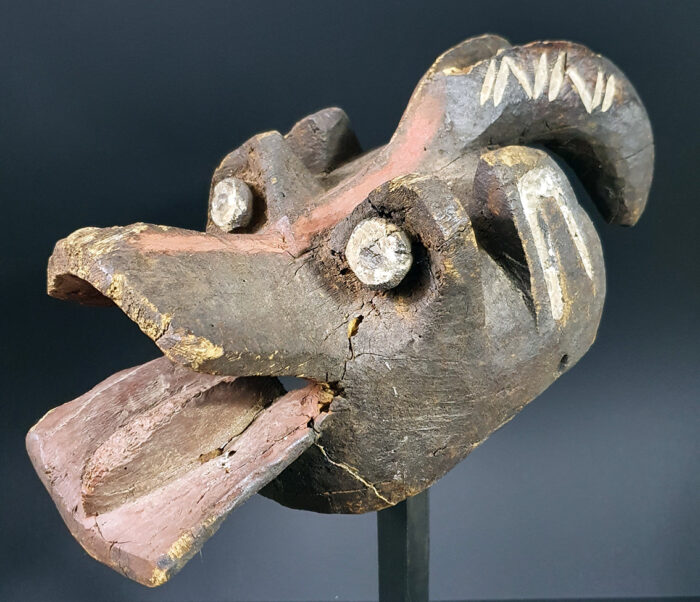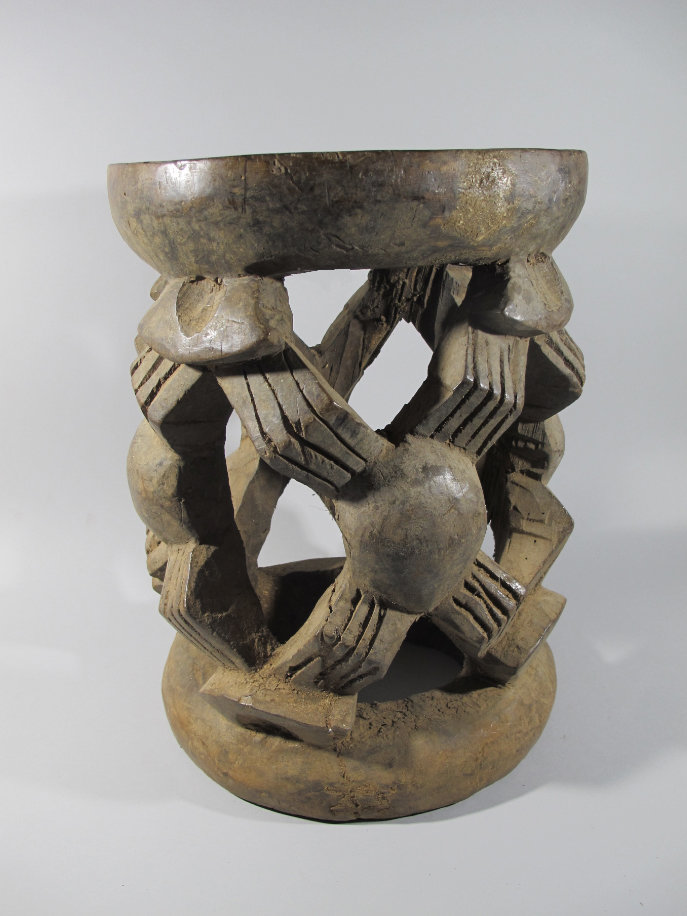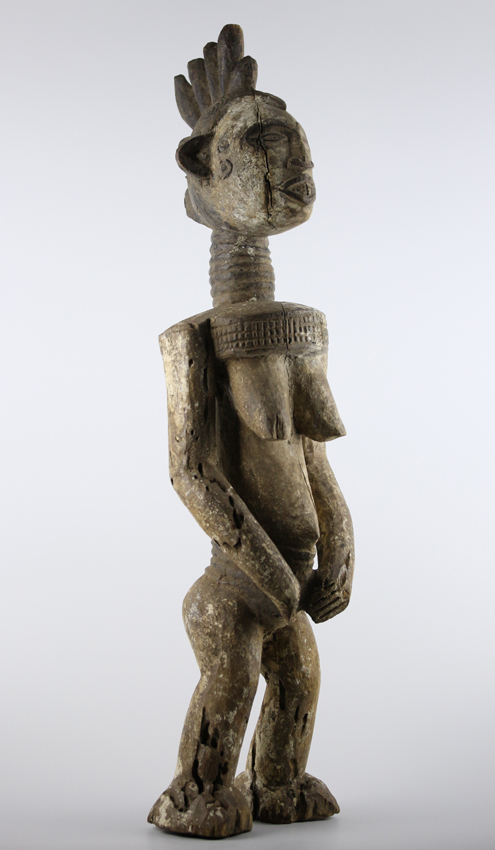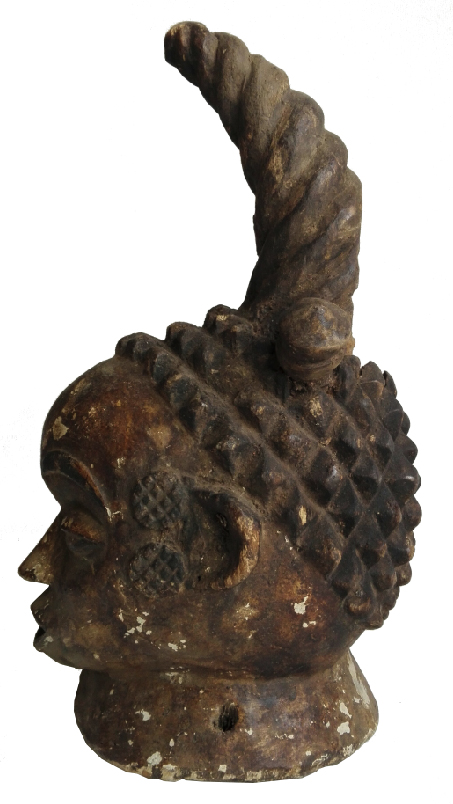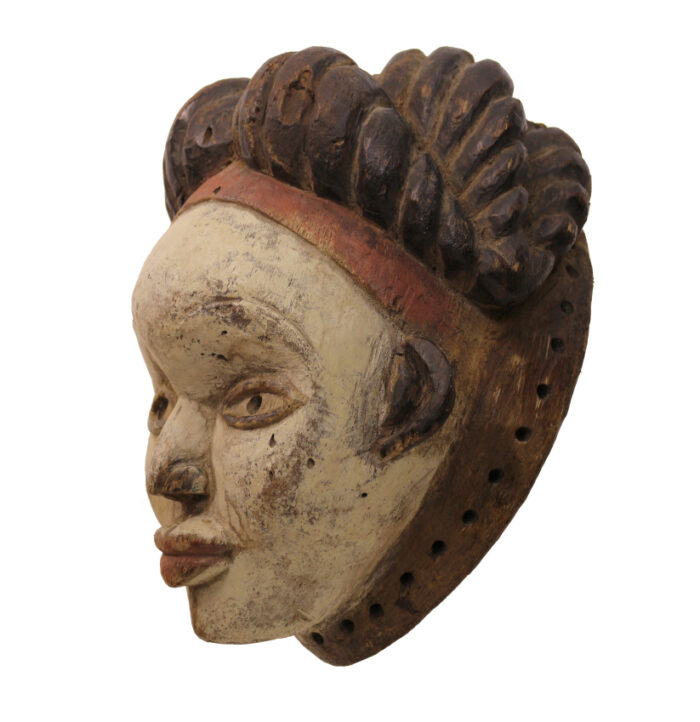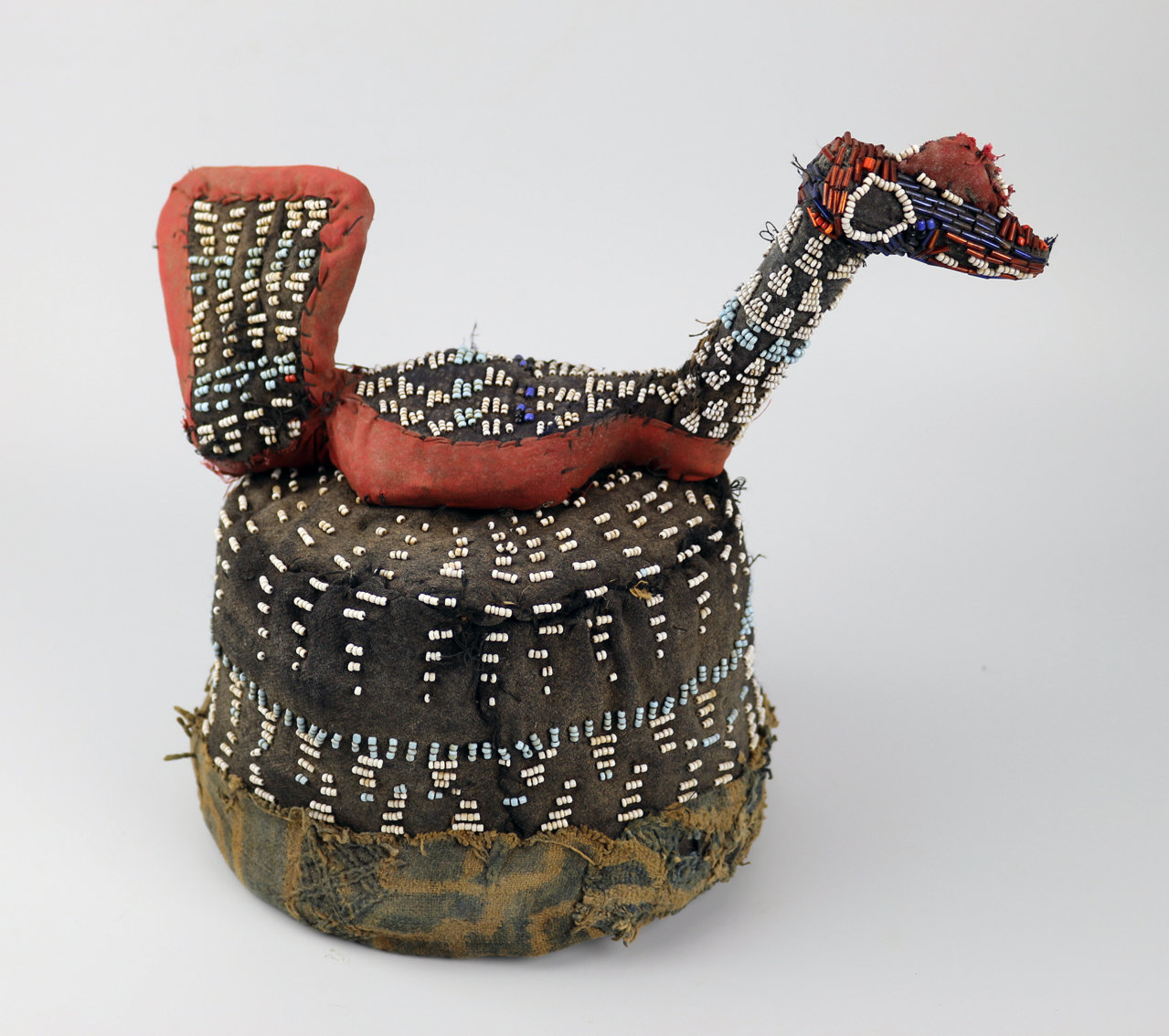Gabon, Masque Fang
€2.900,00
Catégorie : Masques de tête (visages ou cimiers)
Fang mask, N’Gil. Fang Gonta mask.
(Bitam Village / Owem Province)
This mask comes from an old fang tradition.
The “Ngil” was a company (in the group sense) of a judicial nature. Its purpose was the search and the setting out of state to harm beyem sorcerers charged with an evil spirit.
The initiation to “Ngil” included:
a prior physical and moral purification;
flogging;
a confession of crimes and / or breaches of prohibitions;
an ordinal test;
a presentation of the relics of the ancestors (byeri);
sacrifices.
It was a symbolic passage from the androgynous state to the adult, sexually defined state. The sacred place of “Ngil” was a rectangular clearing of bush called ésam, with large recesses of wet earth of vaguely human form representing “Ngil” and his wife.
The neophytes had to crawl in front of these effigies by passing over a pit in which were hidden warriors seeking to wound them with their weapons. They also had to undergo the ant test. Only men could be introduced to “Ngil”. The “Ngil” was basically used to protect the individual against evil and poisoning. It was part of the rituals of regulation of traditional Gabonese village life.
The ritual continued in the village courtyard in the early morning or at dusk. Armed with a ritual saber or a simple club, the “Ngil” was supposed to destroy the huts of villagers in conflict with other members of society. These discussions focused on adultery, theft or debts. The mask wearer had a deep voice that frightened women and children.
***
Fang mask, N’Gil. Bitam Village / Owem Province. Fang Gonta mask.
This mask comes from an ancient fang tradition.
The “Ngil” was a society (in the sense of group) of a judicial nature. His goal was to search and incapacitate beyem sorcerers charged with an evil spirit.
The initiation to “Ngil” included:
a prior physical and moral purification;
flogging;
a confession of crimes and / or breaks of prohibitions;
ordalic ordeal;
a presentation of the relics of the ancestors (byeri);
sacrifices.
It was a symbolic passage, from the androgynous state to the adult, sexually defined state. The sacred place of the “Ngil” was a bush clearing, rectangular in shape, called esam, with large recumbent mounds of vaguely human wet form representing “Ngil” and his wife.
The neophytes had to crawl before these effigies by passing over a pit in which were hidden warriors trying to hurt them with their weapons. They also had to be tested by ants. Only men could be initiated into “Ngil”. The “Ngil” was in fact used as protection of the individual against evil spells and poisonings. It was part of the regulatory rituals of traditional Gabonese village life.
The ritual continued in the village courtyard early in the morning or at dusk. Armed with a ritual sword or a simple club, the “Ngil” was supposed to destroy the huts of villagers in conflict with other members of society. These palavers were about adultery, robbery or debt. The wearer of the mask had a deep voice that frightened women and children.
***
Fang Maske, N’Gil. Bitam-Dorf / Owem-Provinz. Fang Gonta Maske.
Diese Maske stammt aus einer alten Fangtradition.
Das “Ngil” war eine Gesellschaft (im Sinne einer Gruppe) juristischer Natur. Sein Ziel war es, Zauberer zu finden, die mit einem bösen Geist aufgeladen waren.
Die Einweihung zu “Ngil” beinhaltete:
eine vorherige körperliche und moralische Reinigung;
Auspeitschen;
ein Geständnis von Verbrechen und / oder Pausen von Verboten;
Ordalische Tortur;
eine Präsentation der Reliquien der Vorfahren (byeri);
Opfergaben.
Es war eine symbolische Passage, vom androgynen Zustand zum erwachsenen, sexuell definierten Zustand. Der heilige Ort des “Ngil” war eine rechteckige, rechteckige Buschlichtung, genannt Esam, mit großen, liegenden, menschenähnlichen Nischen, die “Ngil” und seine Frau darstellen.
Die Neophyten mussten vor diesen Abbildern durch eine Grube klettern, in der sich versteckte Krieger befanden, die versuchten, sie mit ihren Waffen zu verletzen. Sie mussten auch von Ameisen getestet werden. Nur Männer konnten in “Ngil” eingeweiht werden. Das “Ngil” wurde tatsächlich als Schutz des Individuums vor bösen Zaubersprüchen und Vergiftungen verwendet. Es war Teil der regulatorischen Rituale des traditionellen Gabuner Dorflebens.
Das Ritual ging frühmorgens oder in der Abenddämmerung im Hof des Dorfes weiter. Mit einem rituellen Schwert oder einem einfachen Club bewaffnet sollte der “Ngil” die Hütten der Dorfbewohner zerstören, die sich im Konflikt mit anderen Mitgliedern der Gesellschaft befanden. Diese Palaver waren über Ehebruch, Raub oder Schulden. Der Träger der Maske hatte eine tiefe Stimme, die Frauen und Kinder erschreckte.
Vendor Information
- Store Name: collectingafricanart.com
- Vendor: collectingafricanart.com
- Address:
- No ratings found yet!
- Vue Rapide
- Vue Rapide
-
Vue Rapide€2.600,00
- Vue Rapide
-
Vue Rapide€4.200,00
- Vue Rapide
